Due to a weather issue which left an attorney grounded, the court hearing on environmental review for the city’s planned design changes to Fort Greene Park was postponed.
The case, filed by Friends of Fort Greene Park and Sierra Club, argues that the planned changes to the park must go through an environmental review as required by state law. The city refutes and argues that the planned changes are not of that scale.
The people behind the suit are opposed to the planned redesign of the park, which is part of the Parks Department’s “Parks without Borders” initiative. The redesign would add more pavement and create a pedestrian plaza. Opponents are concerned that the changes will alter the character of the park by removing trees and green space and making it a place for events and vendors, instead of local residents.
Although there is no debate on whether the Parks Department has authority to make the changes, but there is hope that an environmental review process as required by state law will formulate the group’s concerns.
“We believe there will be provable environmental negative effects,” said Enid Braun, a member of Friends of Fort Greene Park. “We know the benefits of trees. There is science and we believe that removing that many trees will have this negative effect. They never studied bird migration patterns, things like that as well. But just in terms of climate change, the removal of so many trees in an area that’s got a high asthma rate seems indefensible.”
The Parks Department declined to comment due to ongoing litigation and referred to filed court documents. In those, the city’s attorney states that there will be a net increase in trees and that any tree removal which may be undesirable is irrelevant to the requirement for an environmental review process.

Opponents argue that trees being planted to mitigate the planned removals won’t be able to properly replace the ones currently in the park. “Not all those trees will be planted in this area and they will be three to five-inch caliper trees which will take 20 to 30 years to reach a size to produce the same kind of climate mitigations that mature trees do,” said Braun. “What we’re asking for is an environmental study because we believe there really will be tremendous environmental impact.”
Under current state law, for an action by the Parks Department to trigger an environmental review process it must be a “Title 1” action, rather than a “Title 2” action. Part of what would make classify a project as a Title 1 action would be the physical alteration of over 10 acres. The lawsuit alleges that the planned Fort Greene changes exceed that number, while the city’s attorney claims that only 9.85 acres will be affected, with 2.01 acres serving as a buffer area during construction.
For opponents, the changes go beyond state statutes. They fear a plaza would be used mainly for events and for people to pass through the park, rather than serve as accessible green space for local residents.
“Their renderings showed vendors. So it’s likely they see it as a revenue-producing plaza for events which the Parks Department does all over the place. They charge a rent for special events,” said Braun. “It’s not the use that the park users currently have. People use this part of the park for their family gatherings, their church events, their picnics, their barbecues. It’s their backyard and by redesigning it, it gives the message to the current users that it’s not for those traditional neighborhood uses.”
“I think there’s a subtle message when you completely alter a public space, that ‘this isn’t for you’,” Braun added. “But that’s a harder thing to prove.”
The new date for the hearing is 9:30 a.m., Tuesday, Sept 10 at New York County Supreme Court, 80 Centre Street, Room 122 in Lower Manhattan. Friends of Fort Greene urges people to attend.










